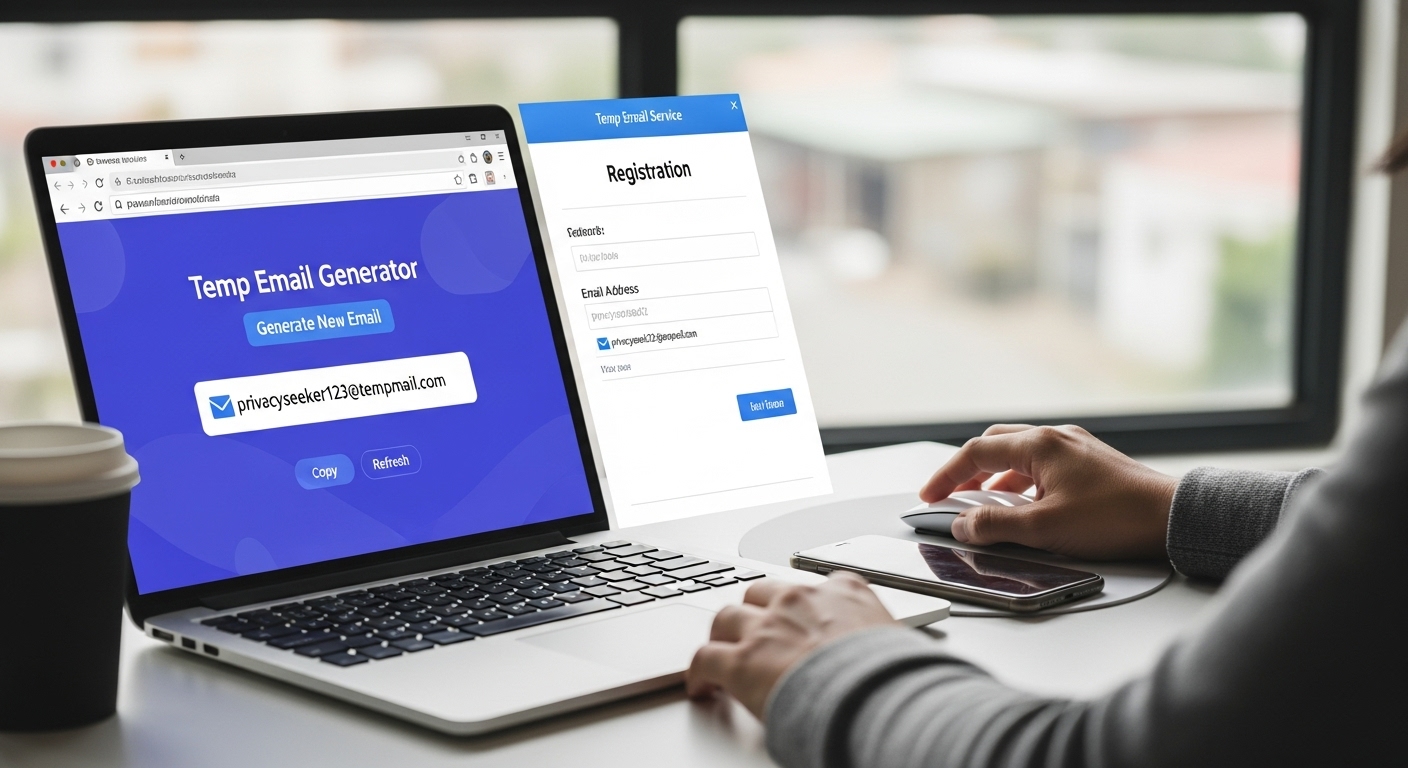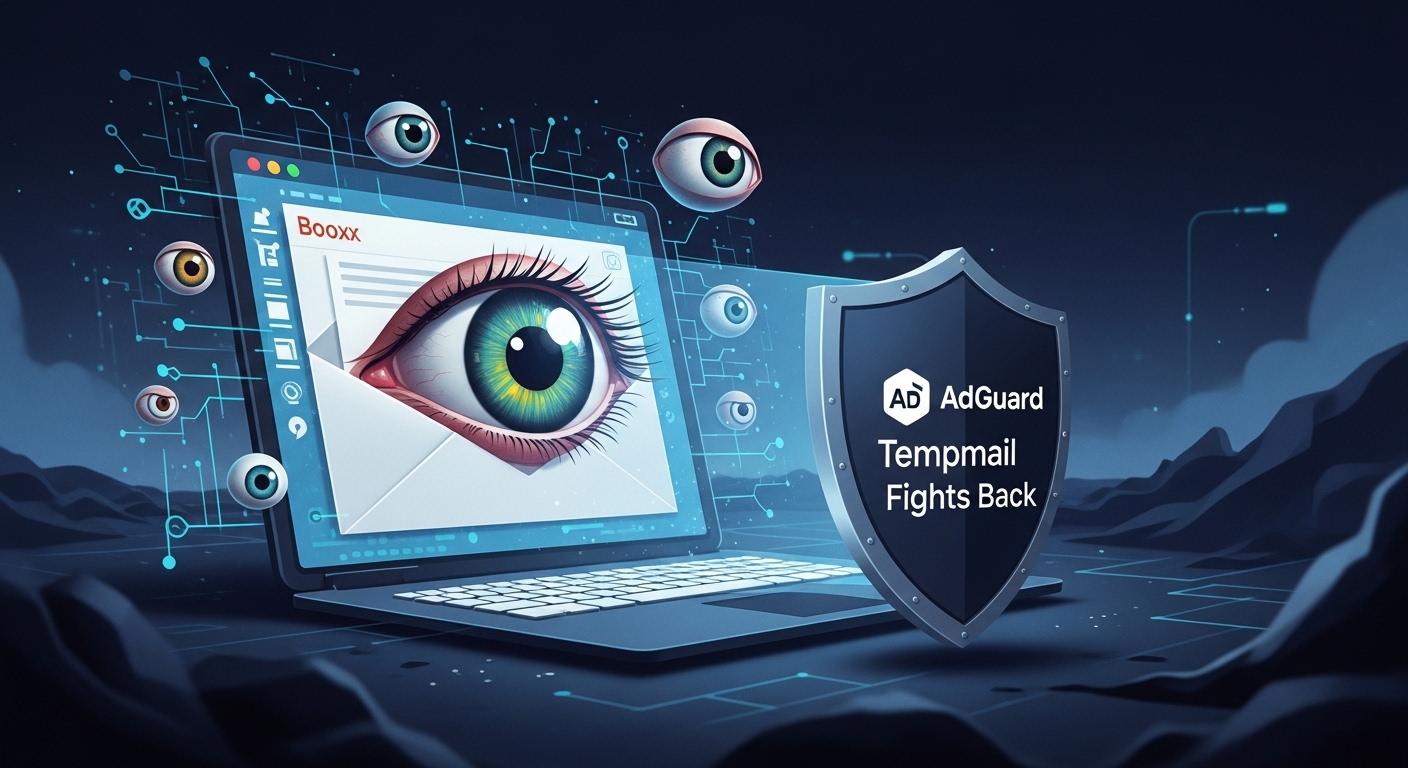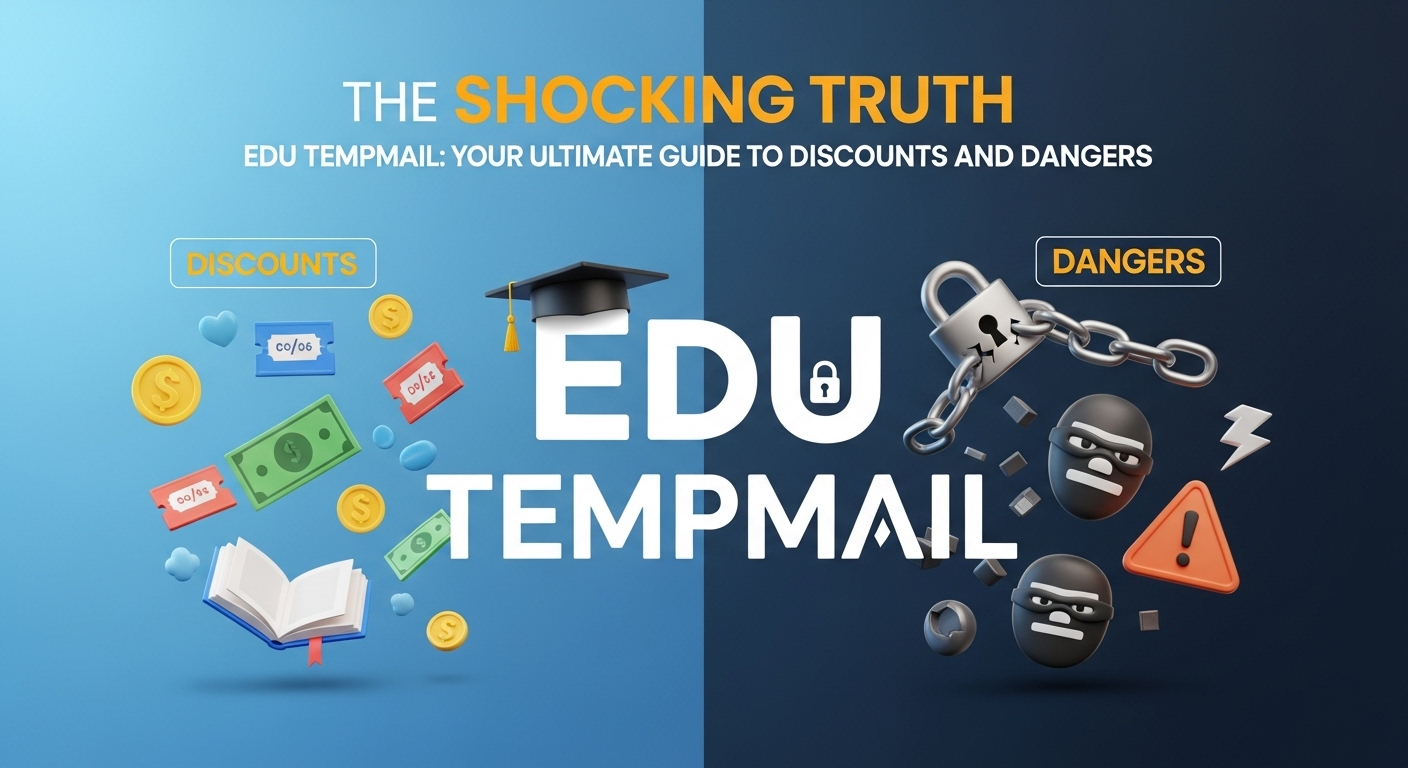How to Use a Temp Email Generator

Does opening your email feel like a chore? You wade through a sea of promotional offers, newsletters you don't remember subscribing to, and suspicious messages promising untold riches. If you feel like your inbox is a public billboard for spammers, you're not just imagining it. In 2025, the world sends and receives a mind-boggling 376.4 billion emails every single day. The shocking part? Nearly half of that—a staggering 47%—is pure spam.
What if you could become a digital ghost? What if you could navigate the web, sign up for services, and download content without ever revealing your true identity? This isn't science fiction. This is the power of a temp email generator.
What Exactly is a Temp Email Generator?
Let's demystify this powerful tool. A temp email generator creates a temporary, functional, and completely disposable email address that self-destructs after a short period. Think of it like a digital P.O. box that vanishes into thin air right after you've picked up your package. It's a real email address with a real inbox, but it’s not tied to you, your name, or your personal data in any way.
You’ve probably heard it called by many names, but they all refer to the same core concept:
- Disposable Email
- Burner Mail
- Throwaway Email
- 10-Minute Mail
- Fake Email
No matter the name, the process is brilliantly simple. You visit a service's website, and it instantly generates a new email address for you—no sign-up, no password, no personal details required. This address is active for a limited time, from ten minutes to a few hours, during which you can receive emails just like a normal account. Once the timer runs out, the address and all its contents are permanently deleted, leaving no trace.
The true genius of a temp email generator lies in its ability to completely decouple your actions from your permanent digital identity. Your primary email is the central hub of your online life, linked to everything from your bank account to your family photos. Each time you use it to sign up for a new service, you're connecting that service directly to your core identity, creating another potential point of failure—what security experts call expanding your "attack surface". A temporary email creates an isolated, single-purpose identity that isn't connected to anything else. If that temporary identity is ever spammed, hacked, or exposed in a data breach, the damage is contained. It’s a dead end for hackers and spammers, protecting your real inbox and your core digital life. This is a fundamental principle of modern cybersecurity—compartmentalization—made accessible to everyone with a single click.
5 Reasons to Use a Disposable Email Today
Still on the fence? Let's break down the powerful, real-world benefits of adding a disposable email address to your digital toolkit. This isn't just about convenience; it's about fundamentally changing how you interact with the online world.
- Bulletproof Spam Protection: This is the most immediate and satisfying benefit. Every time you use a temporary email for a one-time registration, a newsletter you're curious about, or to download a free e-book, you are building a fortress around your real inbox. All the inevitable follow-up marketing emails, spam, and unwanted clutter go to the disposable address, which simply ceases to exist. Given that nearly half of all email traffic is spam, this isn't a small victory; it's reclaiming your time and sanity.
- Fortify Your Online Privacy: In today's digital economy, your data is the product. Marketers, data brokers, and tech giants track your online behaviour, often using your email address as a unique identifier to build a detailed profile about you. A temp email generator breaks this chain of surveillance. By using a different, anonymous address for various services, you prevent these companies from connecting the dots and tracking you across the web. As whistleblower Edward Snowden famously said, "Dismissing privacy because you have 'nothing to hide' is like dismissing free speech because you have nothing to say". Your privacy is a right, and this tool helps you protect it.
- Enhance Your Security: Data breaches are now a fact of life. When a service you've signed up for gets hacked, your email and password can be exposed. A temporary email acts as a crucial security buffer. If the disposable address is leaked in a breach, it's a dead end for hackers. They can't use it to access your other, more important accounts, and it significantly reduces your exposure to targeted phishing attacks designed to trick you into giving up sensitive information.
- Unlock the Web Anonymously: How many times have you wanted to try a service, join a forum, or grab a discount code without committing to a lifetime of emails? A disposable email is your key to the web without strings attached. Use it for:
- Free Trials: Test out software or streaming services without getting added to their marketing lists.
- Online Shopping: Get one-time discount codes without being spammed with promotions forever.
- Forums & Comments: Participate in online discussions without revealing your real identity.
- Accessing Content: Download whitepapers, case studies, or articles that are locked behind an email wall. For example, you can create a Canva account in seconds without ever using your personal address.
- A Developer's Best Friend: For software developers and quality assurance (QA) testers, temporary emails are an indispensable tool. They allow for the rapid creation of multiple user accounts to test registration forms, password reset flows, and email notification systems. This can be done without cluttering up real inboxes or creating a database full of fake-but-permanent user accounts, making the testing process cleaner, faster, and more efficient.
How to Use a Temp Email Generator in 60 Seconds:
The beauty of a temp email generator is its sheer simplicity. You don't need to be a tech expert to use one. In fact, you can create and use a disposable email in less time than it takes to brew a cup of coffee. This straightforward process is perfect for quickly getting what you need online without the hassle.
Here’s a simple, step-by-step guide to get you started:
- Visit a Temp Email Provider: Open your web browser and navigate to a reputable temp email generator website. A great place to start is a service like (https://temptomail.org).
- Instantly Get Your New Email: The moment the page loads, the service will automatically generate a unique, temporary email address for you. You don't have to do anything. It will be displayed prominently on the page.
- Copy the Address: Next to the generated email address, you'll see a "Copy" button. Click it. The address is now copied to your clipboard, ready to be used.
- Paste it Where You Need It: Go to the website, app, or forum where you need to sign up. When it asks for your email address, simply paste the temporary one you just copied. Fill out the rest of the form as needed and submit it.
- Check Your Temporary Inbox: Switch back to the temp email generator website. The page will have an inbox section. Within a few moments, the confirmation or verification email from the service you signed up for will appear there. You may need to click a "Refresh" button to see it.
- Verify and Finish: Open the email right there in your browser. Click the confirmation link or copy the verification code as required. Your account on the other website is now active.
That's it! You're done. You can now close the temporary email tab. The address and its contents will be automatically deleted after its time expires, leaving no trace.
For a visual walkthrough, check out this helpful YouTube tutorial that demonstrates the process of signing up for a service using a temporary email.
When NOT to Use a Temporary Email
While a temp email generator is a fantastic tool for privacy and convenience, it's not a silver bullet for every situation. Using it in the wrong context can lead to serious problems, from losing access to your accounts to compromising sensitive information. To use this tool wisely, you must understand its limitations. Being aware of the risks is a cornerstone of good digital security.
Here are the critical situations where you should NEVER use a temporary email:
- Sensitive Financial and Banking Accounts: This is the golden rule. Never use a disposable email for your bank, credit card company, PayPal, or any other financial service. These accounts require a stable, secure, and permanent email address for critical security alerts, password resets, and two-factor authentication.
- Important Personal and Government Services: Do not use a temporary address for healthcare portals, government services (like tax or voter registration), or legal documents. You need long-term access to these accounts for important notifications and to verify your identity.
- Long-Term Social Media or E-commerce Accounts: If you're creating an account you plan to use for a long time—like your main Facebook, Amazon, or Apple ID—always use your real, secure email. If you ever get locked out or forget your password, you will have no way to recover your account once the temporary email has expired.
- Any Service Where You Might Need to Recover a Password: This is the biggest risk. A temporary email is designed to be forgotten. If you use it for any account and later forget the password, you are permanently locked out. The password reset link will be sent to an email address that no longer exists.
Beyond these critical warnings, there are other practical limitations to consider:
- They Can Be Blocked: Many popular websites and online services are wise to temporary email domains. They maintain blocklists and will prevent you from signing up if they detect you're using a disposable address.
- Security Can Be Weak: Many free services are not designed for security. Their inboxes are often public and not password-protected. This means that if someone else knows or guesses your temporary address, they might be able to see your emails, including verification links or codes.
To help you make a quick, informed decision, here is a clear breakdown of the pros and cons.
| Pros of Using a Temp Email | Cons of Using a Temp Email |
| Instant & Free: No sign-up or payment required. | Account Loss Risk: Address expires, locking you out of password resets. |
| Blocks Spam: Keeps your primary inbox clean. | Blocked by Services: Many websites detect and reject temp emails. |
| Protects Real Identity: Enhances privacy and anonymity. | Insecure for Sensitive Data: Unsuitable for financial or personal accounts. |
| Reduces Data Breach Exposure: Your real email isn't in leaked databases. | Public Inboxes: Some services have shared inboxes, posing a privacy risk. |
Temp Mail vs. Email Alias:
As you dive deeper into the world of online privacy, you'll encounter another powerful tool: the email alias. While often used interchangeably with "temporary email," they are fundamentally different tools designed for different purposes. Understanding this distinction is key to choosing the right level of protection for your needs.
Let's break it down:
- Temporary Email (The Burner): This is what we've been discussing so far. It's a completely separate, self-destructing inbox. It's designed for a single, short-term use and is then discarded forever. Think of it as a disposable camera—you use it for one event and then it's gone.
- Best for: One-off sign-ups, quick verifications, and situations where you need maximum anonymity and have no intention of ever interacting with the service again.
- Disposable Email Alias (The Mask): An alias is a unique, permanent forwarding address that "masks" your real email. All emails sent to the alias are automatically forwarded to your primary inbox, but the sender never sees your real address. You can reply to these forwarded emails, and your reply will appear to come from the alias, keeping your true identity hidden. You can create dozens of aliases and turn them off or delete them anytime you want.
- Best for: Signing up for services you plan to use long-term (like newsletters, online stores, or social media) while still protecting your primary email from spam and data breaches. It gives you both privacy and control.
Many popular email providers offer basic alias functionality. For example, with Gmail, you can add a plus sign (+) and any word to your address (e.g., yourname+shopping@gmail.com), and the emails will still arrive in your main inbox, allowing you to create filters. Outlook offers a similar feature.
However, for true power and privacy, dedicated alias services are the way to go. Platforms like(https://simplelogin.io/) and AnonAddy are built specifically for this purpose. They allow you to create unlimited random aliases, use your own custom domains, and even add advanced security features like PGP encryption. Apple users with an iCloud+ subscription have a similar feature built-in called "Hide My Email," which generates random, forwarding addresses for apps and websites.
The Best Temp Email Generator Services of 2025 (Reviewed & Compared)
Now that you understand the what, why, and how, it's time to choose the right tool for the job. The market is filled with options, each with its own strengths. Whether you need a quick burner for a one-time verification or a robust alias manager for long-term privacy, there's a service for you.
We've reviewed and compared the top temp email generator and alias services available today to help you make an informed choice. For a reliable and user-friendly experience that balances simplicity with powerful features, services like (https://temptomail.org) offer a great starting point for anyone new to disposable emails.
Here is a comprehensive comparison of the best services in 2025:
| Service | Key Feature | Best For | Anonymity Level | Link (Outbound) |
| (https://temp-mail.org/) | Industry-standard reliability and simplicity. | Everyday quick sign-ups and verifications. | High | Link |
| 10MinuteMail | Strict 10-minute self-destruct timer. | Extremely fast, one-off tasks where speed is critical. | High | Link |
| Guerrilla Mail | Ability to send anonymous emails from the temp address. | More advanced free use cases, like anonymous replies. | Medium | Link |
| Proton Mail | End-to-end encryption and Swiss privacy laws. | Ultimate security for a primary inbox (not disposable). | Very High | Link |
| (https://simplelogin.io/) | Unlimited, permanent forwarding aliases with PGP support. | Long-term, secure management of multiple online identities. | Very High | Link |
| AnonAddy | Open-source, self-hostable, and highly customizable. | Tech-savvy privacy enthusiasts who want maximum control. | Very High | Link |
Conclusion:
In the digital age, your attention is a currency, and your personal data is a commodity. Every day, countless companies and individuals vie for a piece of it, leading to the overwhelming spam, invasive tracking, and constant security threats that have become a frustrating part of modern life. But it doesn't have to be this way.
A temp email generator is more than just a clever trick to avoid junk mail. It is a simple yet profound declaration of your right to privacy. It's a tool that empowers you to draw a line in the sand, to decide who gets access to your true identity and on what terms. It allows you to explore the vast resources of the internet with confidence, knowing that your primary inbox—the digital hub of your life—remains clean, secure, and under your control.
Your digital privacy is in your hands. The next time a website asks for your email in exchange for a small piece of content or a discount, don't hesitate. Try a temp email generator and experience the freedom of a cleaner, more secure, and more private online world.
Frequently Asked Questions (FAQ)
1. Is using a temp email generator legal?
Yes, using a temporary email generator is completely legal for legitimate purposes like protecting your privacy from spam, testing websites, and avoiding unwanted marketing. However, using them to engage in illegal activities, fraud, or to violate a service's terms of use is, of course, against the law.
2. Can temporary emails be traced?
It is very difficult, but not impossible. While the email address itself is anonymous, the service provider may log your IP address. For true anonymity, security experts recommend using a temporary email service in conjunction with a trusted VPN, which will mask your real IP address.
3. What's the difference between "temporary" and "disposable" email?
The terms are often used interchangeably. Generally, a "temporary email" refers to an address with a very short, fixed lifespan (like 10 minutes) that self-destructs. "Disposable email" is a broader term that can include these temporary addresses as well as permanent email aliases that you can create and delete ("dispose of") at will.
4. How long does a temp mail last?
The lifespan varies greatly depending on the service. Some, like 10MinuteMail, last for exactly 10 minutes (with an option to extend). Others may last for an hour, a day, or until you manually delete the address.
5. Can I send emails from a temporary address?
Most free, simple temp email generator services are designed for receiving emails only. However, some more advanced services, like Guerrilla Mail, do allow you to compose and send anonymous emails. All email alias services (like SimpleLogin or AnonAddy) are fully capable of sending and replying to emails.
6. Are free anonymous email generators really safe?
They are safe for their intended purpose: protecting your real email address from spam and exposure. However, they are generally not secure for sensitive information. Many lack password protection or encryption, meaning the contents of the inbox could potentially be viewed by others. Never use them for anything confidential.
7. Will websites know I'm using a disposable email?
Often, yes. Many websites and online services use verification tools that check an email address against a known database of disposable domains. If a match is found, they may block your registration. This is a common limitation of using these services.
8. What happens if my temporary email expires and I need it again?
You will permanently lose access to that email address and any account associated with it. This is the single biggest risk of using temporary emails for anything other than one-time interactions. You will not be able to reset your password or receive important notifications.
9. Can I receive attachments with a temp mail service?
Yes, most modern temporary email services fully support receiving emails with attachments. You can typically view and download these attachments directly from the temporary inbox in your browser.
10. What is the best free temp email generator for privacy?
For quick, anonymous, one-off tasks, a service like Temp-Mail.org is excellent due to its reliability and ease of use. For users seeking better long-term privacy and control, the free tier of an email alias service like SimpleLogin is a superior choice, as it provides permanent, manageable aliases that forward to your real inbox securely.
Please don’t forget to leave a review of my article.
You Might Also Like
Is Your Inbox Spying on You? Here’s How AdGuard Tempmail Fights Back
Have you ever paused before entering your email address into a new website, feeling a slight hesitation? That feeling is...

The Shocking Truth About Edu Tempmail: Your Ultimate Guide to Discounts and Dangers
Imagine getting over 60% off Adobe Creative Cloud and half-price Amazon Prime. What if you could get those deals without...

Why Your Hotmail Is a Privacy Nightmare (And How Temp Mail Can Save You)
Did you know that nearly half of all emails sent worldwide are spam? In 2024, spam accounted for a staggering 47.27% of ...

The Ultimate Deception: Is Tempmail Safe, or a Ticking Time Bomb?
Your email inbox is more than just a place for messages. It's the digital key to your entire online life. Every password...

The Ultimate Betrayal: How Your Inbox Is Selling You Out (And How to Use Tempmail to Stop It)
Your inbox is a battlefield. Every single day, a war is waged for your attention, your data, and your money. Don't belie...

Your Digital Shield: The Astonishing Truth About How Temp Mail Works
Opening your email inbox can feel like walking into a battlefield. You’re constantly dodging a barrage of promotional ju...

